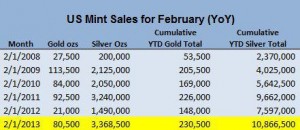Pay attention GLD, PHYS, PSLV, and SLV investors – the US Mint’s full February sales numbers show unprecedented amounts of gold and silver Eagles sold. We will go inside the numbers to show this to investors, but the strong physical sales may be a sign that the drop in prices is not the end of the bull market, but just a long, painful correction.
Analyzing the U.S. Mint Sales Numbers
When analyzing sales numbers, it is important that investors go past the headlines and dig deep into the true nature of the sales. For brevity, we are only showing the last few years of sales, but for doing comparisons, we have used data from the beginning of the current bull market in 2001.
To start, let’s take a look at the U.S. Mint sales numbers for silver and gold for February and compare them to the same month in previous years. We are doing a year-over-year comparison because coin sales are very seasonal in nature; to get a fair read, we have to compare February to February.

The first thing that stands out about the numbers is the massive amount of silver eagle sales totaling 3,368,500 ounces – which is the highest amount ever sold by the U.S. Mint for the month of February. These tremendous February sales followed a January month that saw the largest amount of silver eagles ever sold. In fact, if you look at cumulative year-to-date silver sales (for January and February) the U.S. Mint has sold 10.8 million ounces, which is more than 10% higher than the next best period from 2011 – which silver enthusiasts will remember was the launch pad for silver’s rise to $49.
Most blogs have been raving about the February silver sales, but the gold sales were not too shabby either. In terms of February numbers, the gold sales were the fourth highest total during this bull market, not a bad performance, but not all that impressive on an ounces-sold basis. If you look at gold sales cumulatively, however, gold sales on a year-to-date basis have totaled 230,500 ounces for 2013 – which is the highest amount of gold sales on this basis since the bull market began. Not that it is necessarily a predictor of future prices, but 2011 (the second highest gold sales on a YTD basis) was also the year that gold staged its rise to over $1900 per ounce.
When looking at it on a number of ounces-sold basis, these numbers are impressive for both metals. But when analyzing it on a dollar basis, these numbers become truly staggering.

In the table above, we have used the average monthly London price fix to calculate the dollar value of the month’s bullion sales. Investors can see that monthly silver sales (in terms of the total dollar amount) have soared to 10% higher than the previous high. This should not surprise anyone as the total amount of silver eagles sold was the highest ever, as such, the dollar amount sold would necessarily also be the highest ever. Additionally, the year-to-date dollar amount of silver eagles sold is at a record high of $562 million – more than 15% higher than the previous record.
But gold is the metal that really shines when looking at this table. Even though February was only the fourth highest month in terms of gold eagle ounces sold in this bull market, it was the HIGHEST February ever in terms of the dollar value of those sales. Not only was it the highest ever, but it was the highest ever by a landslide – more than 20% higher than the previous record. Finally, when investors look at the year-to-date numbers, it is more of the same, the $625 million dollars worth of gold sold dwarfs the previous high by more than 25%!
Who is Buying All this Bullion?
So the question that investors should ask is, “Who is buying all this bullion?” The natural inclination is to say the gold bugs, the same people who have been buying gold and silver for the last ten years. But the problem is that most gold bugs have probably invested as much as they are able to invest into bullion already. A good portion have also been heavily invested in the mining stocks, which have performed horribly over the last few years, so there is not a lot of extra profits to rotate into bullion. I expect most gold bugs have exhausted their cash reserves and are simply buying whatever their standard monthly allocation is and little more.
Next, we turn to the average American looking to protect his savings against inflation. Most of these people have not been involved in the bullion market or only have a little skin in the game. The problem with this audience being the buyers of all this bullion is that the stock market has been doing well over the last few months, while gold and silver have been dropping – this is not really the environment that screams to mainstream investors to put money into precious metals (especially not in bullion form that is tougher than ETFs to liquidate). Even though it’s anecdotal evidence, I have seen little interest from anybody who had not already been buying bullion heavily that recently had been putting great amounts of money into bullion. There are no lines outside of coin stores and commercials on primetime television advocating the benefits of buying gold and silver eagles, no evidence suggests that the average American is buying any more gold than he used to. In fact, it is quite the opposite with most of the media declaring the end of the gold bubble.
Unfortunately, there are no clear answers to this question, but maybe a clue comes from the trading strategy of master trader Richard Wyckoff, a trader in the 1920′s and 1930′s. This strategy, which is discussed a bit by the Financial Post, essentially says that the best way to succeed in the markets is to watch the “big operators” and understand what they do and how they make money. Wyckoff discusses how these big operators will bid down a stock or commodity through different types of strategies, while accumulating. Then once others join in on the slaughter, these big operators will be buying that asset off of the hands of these new entrants. Finally, when they have attained their full position, they will use the same strategy in reverse and bid up the asset and clear out those who jumped on the short selling bandwagon and make a lot of money doing it.
This process is nothing new and is one of the oldest strategies in Wall Street, buy when everyone else is selling and then sell when everyone else is buying. And it works even better if you can push people into buying or selling – which big players can do.
The interesting thing about the gold and silver market is that you are seeing a tremendous divergence between the quoted price of the precious metal and what is happening in the physical market, as evidenced by eagle sales. In fact, if you only saw the sales numbers (and not the price of gold/silver), you would think that they have been having a terrific few months of price appreciation – which is clearly opposite to what has happened. Could it be that the same players that are selling on the paper markets are also buying on the physical markets? Obviously, this is just conjecture but if this is the case, it would make Mr. Wyckoff very proud.
Based on the U.S. Mint sales numbers, gold and silver are being bought at an unprecedented level, which is running counter to what is happening to the price of the precious metals. When investors see such strange divergences in asset pricing, where physical sales are surging while the price of the asset is dropping, to profit they really need to try and understand what is happening. Unfortunately, I do not have the means to answer who is buying these large amounts of precious metals.
For gold and silver ETF investors (GLD, SLV, PHYS, PSLV), these strong physical sales are a very bullish sign because there is a big difference between those who buy paper silver (short-term traders and weak hands) and those who buy the physical metal (long-term buyers and strong hands). After all, investors do not forgo the ease and liquidity of paper gold and silver to buy the physical metal unless they believe there are much higher prices ahead.
Finally, the media reports that have declared the end of the gold bull market and that people are abandoning gold and silver by selling their metal to buy stock, is definitely not what we are witnessing in the physical markets. In fact, the opposite is happening in the physical markets – we are seeing much more buying than in previous years. GLD and SLV investors should hold tight and consider purchasing some physical metal as a hedge to their paper position, because in the battle between physical and paper, investors would be wise to pick the strong hands in this fight.









